
What's all the fuss about workplaces really about? It's not like it can affect anything important like productivity... right?
In the pursuit of making workplaces around the world as smart as the people in them we have become obsessed with all the factors contributing to reaching that goal. Factors which include workplace optimization and design. It turns out we just couldn’t let it go and the result of this obsession has become an endless quest for increased workplace productivity. Who doesn’t love a challenge?
Psst…!
Did you know that if you work 40 hours a week from the age of 20 to the age of 65 you will have worked 90 000 hours in your life. That’s a lot of time to spend in a workplace. No wonder people care so much about it!
Since we’re spending so much time in our workplaces it’s definitely interesting as well as important to know what impact that workplace has on you and everyone around you. Creating a pleasant and effective workplace might be challenging but the reward is priceless. And considering how much time we spend there shouldn’t we at least try?
You might think that our headline “Workplace” is too broad? That’s on purpose. Because the workplace is made out of so many different building blocks, from furniture to workplace culture, we have to go through it all. So, consider this the ultimate workplace manual which is here to educate, guide and support you in the pursuit of a better workplace environment.
The number of different ways you can design a workplace will blow your mind. Historically the major trends on workplace design seem to shift every ten to fifteen years or so. Remember all the cubicles? As time passes more organizations dare to explore more innovative alternatives. By pushing your limits and looking to see what others are doing you can change your workplace in ways you didn’t think was possible. For example; what’s up with all these ping pong tables in offices? Is it just for fun or do they contribute to workplace productivity?
What is space planning? What does it really mean? For some, who have the luxury, space planning can mean designing the spaces of your workplace before your move into it. For others it revolves more around optimizing the space you’re already in. Smart space planning on the other hand is an art form.
Smart space planning entails planning a space based on the potential activities taking place there. It involves calculating the space needed for every activity as well as the equipment and furniture. It also includes knowing your own workplace well. What are your needs? What habits exist in this office and what problems do we have?
Maybe you’ll need to optimize your mobility or maybe you’ll need to create new meeting rooms? When optimizing your mobility you make sure that as much of your needed equipment is mobile. Our CEO Andreas usually recommends portable tv-screens instead of stationary projectors, a portable speakerphone like the Jabra Speak instead of a stationary conference phone, and of course using equipment that supports Bluetooth, having great wifi and using cloud services. These are just a few tips on how you can evolve your office into a mobile-optimized unit where you dictate the conditions and not the office.
Start off by making a list of all of the activities taking place in your office. Ask your coworkers what they think is missing or what they feel they need to do a better job. Then plan your space based on that. Think of what lighting these activities need, what type of furniture, and which technology. Sounds easy enough? Keep reading and we’ll tell you about all of the popular ways to plan your office space. To be able to create the ultimate workplace you’ll need smart space planning as opposed to just planning space. Based on your organization’s needs, problems and habits you should plan spaces, furniture, lighting, and technology to match them. A piece of overall advice is to create more but smaller meeting rooms. 50-70% of all meetings in Sweden contain 1-4 people. So, if you were to be smart about your office space planning you make sure that half of the meeting spaces aren’t conference rooms - they are the biggest space thieves!
Office layouts are a huge part of the office design and as we mentioned earlier the trends here are evident. From separate offices to cubicles to open floor plans. An office layout isn't just about the walls we put up and where we put them. It's about creating a layout that encourages creativity, favors communication and increases productivity. Again – shouldn't be so hard, right?
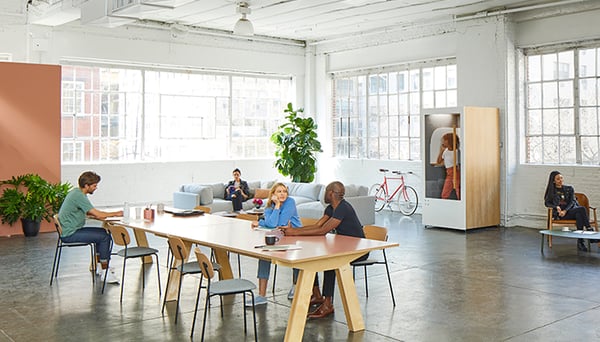
Office layouts
Did you know that the trend of open floor plans dates back long before the cool Silicon Valley people started using it? The first open floor office was designed in 1939. But, as with everything else we got carried away with the design, and too many people were crammed into the same space - so we invented cubicles!
Open floor plans
The initial intent with open floor plans was good though. The purpose of tearing down office walls and creating an open space is to encourage cooperation, transparency, and communication. There are many ways you can plan an office within an open floor plan. You could for example have assigned seating or you could allow coworkers to choose their seats based on the specific need that day. You could also create so-called neighborhoods which are basically what it sounds like. The purpose is dedicating a space to a specific department or group to increase a feeling of togetherness.
Whether your organization would benefit from an open floor plan or not is debatable. It exists an ongoing conversation about what open floor plans do to your office productivity. The truth is that it completely depends on the organization. For larger companies where the work is individual, the productivity could take a toll in an open floor plan but companies based on team projects can benefit from it. Physical openness can lead to better communication, better teamwork, and in the end better ideas.
When considering open floor plans it’s important to weigh the benefits on one hand and the costs on the other.
When working in an open office there are different ways you and your coworkers can use the space and handle the seating. Again, how you choose to plan this should be based on who you are and what is best suited for your needs. If everyone works individually then it might be nice to have an assigned seat.
Assigned seating means that everyone has a permanent seat for themselves. This allows your coworkers to personalize their desks and make them feel more like home. It’s even beneficial to put up personal belongings as long as they stay within company policy.
If the work is based on team efforts and cooperation hot desking could be a better choice. Hot desking means the opposite of assigned seating. It’s more of a first come first serve philosophy. The desks are not possible to book in advance. It enables people to choose a seat based on the task and mood that day.
If you have room - why not do both? Use some of the space for assigned seating and another space for hot desking?
A closed office plan is the opposite of an open floor plan, but you’ve already figured that out. It’s when the workplace is divided into separate offices, cell offices, or cubicles. The purpose is to support individual work and increase focus. In these types of offices, the space for collaboration is usually heavily reduced. This is without a doubt the most classical way of designing an office. A lot of working dreams are built on getting that corner office.
Having said this, just because something is classical doesn’t mean it’s always the best, right? As we mentioned under the segment about open floor plans, there has been an ongoing discussion for a long time about what designs really benefit your organization. The truth is it depends.
There are a lot of organizations where a closed office plan is beneficial for the employees and their productivity. For example, offices that house doctors or lawyers where isolation in periods is crucial to be able to do their job. Any company that demands high focus individual tasks would benefit from a closed plan.
To make a closed plan office successful it’s important that you have enough space. When creating cell offices you have to make sure they’re a comfortable size and therefore closed plan offices can be a bit tricky. An open floor plan is usually financially beneficial since it demands less space which often means less money as well.
In a study made by Leesman, 45% of employees listed 11 activities or more as important tasks in their working lives. This is a clear indication of the development of more complex roles and those complex roles have other needs when it comes to workplace design.
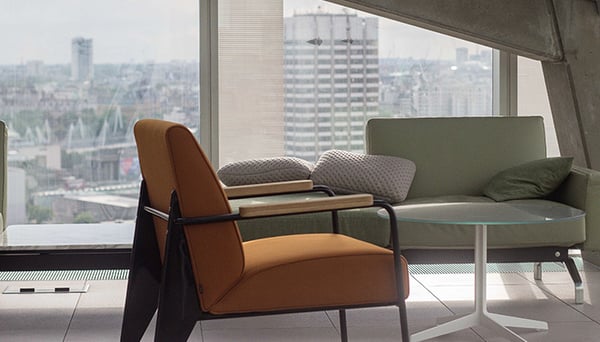
The solution to that need has been activity-based working. Activity-based work or ABW means being able to choose your environment and equipment based on the task ahead. It’s a whole strategy, and a pretty successful one at that, although it puts a high demand on workplace design since there have to be areas designed for every possible need. It often entails both open floor plans and cell offices.
It also entails less assigned seating. Since the choice of area is based on the assignment most of the places are flexible. That in combination with lounge areas and cell offices creates room for focused individual work as well as impromptu meetings, brainstorming sessions, and more official or maybe even secret meetings?
In the study we mentioned above the result of activity-based workplaces was phenomenal. It showed an increase in workplace efficiency and meetings between colleagues. Even though there are a lot of different opinions concerning workplace design most people agree that a variety of work settings is optimal for workplace productivity.
Using this kind of workplace design needs investment from the organization itself. Not necessarily financial but rather an investment of time and patience. It takes a while to get used to and it puts pressure on your coworkers to book areas in advance once they know that they will need it. That also means that all spaces might not be available at all times. But once you get this ball rolling this might not even be a thing.
Have you ever watched sports and seen all the players gathered in a tight circle putting their heads together? That’s a huddle. A huddle room is not that different from a huddle. It’s a space meant to host spontaneous meetings, daily stand-up meetings, and shorter status updates. How a huddle room looks on the other hand differs a bit. It can take its form as a cubicle, phone booth, small pod, or other smaller creative space. The purpose of huddle rooms is to encourage shorter interactions with high focus. They are usually small so think five people maximum.
Pros of huddle rooms:
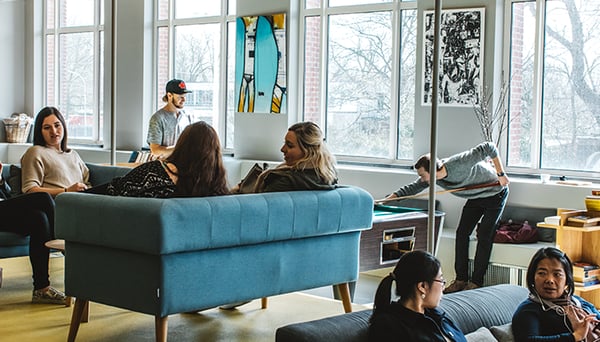
Shared office spaces are the new black, to say the least. Coworking spaces have exploded lately all around the world and everyone seems to want a piece. The purpose of shared office spaces is to house smaller companies or single workers who don’t have their own office and want access to a network.
It usually takes form as a combination of an open floor and closed office plan. Giving the companies the option of choosing their own office or free seating. Shared office spaces often offer a limited amount of bookable conference and meeting rooms available to their tenants.
Whether a shared office space is beneficial for a company or not is entirely based on the needs of that company, as with everything else concerning workplace design. The pros of shared office spaces are the potential ability to save money on rental costs, the fact that you’re not responsible for the facilities or anything in them, the access to a network, and for some “solopreneurs” it’s a place away from home to go to. The cons of shared office space are the possibility of not saving money on rent but instead spending more than you need compared to working from home, for example, the lack of control of what happens at the office and the fact that there are a lot of different brands and cultures in one place which sometimes just means chaos…
We’ve said it once and we’ll say it again, what type of office plan you and your company should choose should be based on your needs and the potential benefits of that office plan. Make sure to weigh your pros and cons before making a decision.
Any office aiming to be somewhat modern or up to date needs to focus time and energy on facility management. Facility management in turn entails everything from light bulbs to technological solutions needed to make the facility work efficiently and foremost to meet the needs of the organizations within the facility.
The older perception of facility management included everything around the office that you could touch basically. From the desks to the locks on the doors, the AC, and the chairs. Today facility management means so much more. It includes all those things as well but in addition to that, it also includes everything that you can’t touch such as technical integration, different software such as IWMS, and the wifi, for example.
With all these new parts of facility management that have exploded during the last decade, or maybe two decades when we think about it, the focus within facility management has shifted a bit. Now the most important factor of facility management is truly knowing your organization. Because when you truly know if you can provide what it needs to function, live and prosper.
Are you opening a new office in another town or maybe in another country even? Then you might need to rethink some of your meeting rooms. Equipment that enables long-distance video conferences should be considered and maybe more flex spaces need to be put in if those afar colleagues come to visit.
The main goals of facility management:
Facility management should go hand in hand with company values and the company brand, such as everything else, to be able to create a complete workplace design.

A workplace is not just defined by its looks and functions but also the work that takes place there. With work comes responsibilities and one of them is being productive, to make sure the job gets done on time. We get that we are not the first ones to say something on this topic, just google workplace productivity once and you’ll see. Although we’re not first we do have something important to say about it. With our knowledge, experience, and mission you can basically say that workplace productivity is our job…
How to increase workplace productivity or productivity anywhere in life is undoubtedly the question on everyone's lips right now. First off, maybe we should quickly explain what workplace productivity actually is? It’s pretty simple. Workplace productivity is the amount of accomplished work in your office environment.
So, how do you increase it? Well, that’s a harder question to answer. But not impossible. There are things you can do for yourself to increase your productivity and there are things management can do for the entire office to maximize workplace productivity. This is an important subject for management to think about. Not only because of the cost in salary but for the wellbeing of your coworkers. Feeling unproductive has a negative effect on us and studies show that workplace productivity increases satisfaction.
What management can do:
Management is not the only one who can affect your productivity. There are little things you can think about as well; get enough sleep (no sleep = BIG no), exercise, keep a clean desk, set realistic goals, plan your weeks and make to-do lists. It can actually do wonders to just organize a little bit - try it and you’ll see.
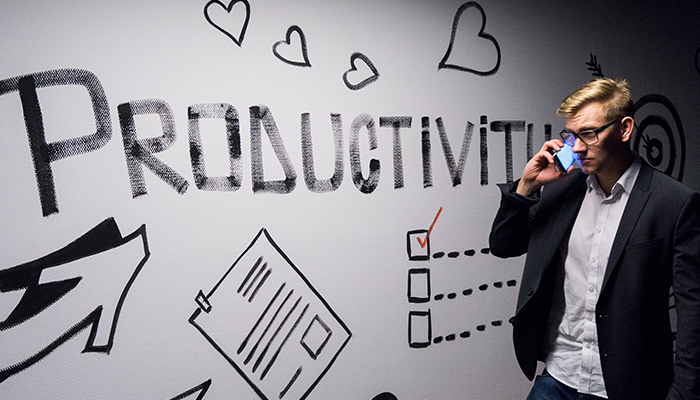
Yes, office tech, as you can understand this topic lies close to our hearts. Having the right integrated workplace management software (IWMS) in place can do so much for your organization’s productivity. The important thing to remember here is to only get technology that makes your work easier. The point is to find tech that works for you, not the other way around.
One of the biggest aspects of office productivity and technology is meeting room management. We get that it’s no surprise that we care about this. But just because we are room booking nerds doesn’t make it less important. Having an ineffective room booking system or not having one at all takes a toll on productivity. Common problems are no-shows, double bookings, no room availability, interruptions during meetings, and the fact that spontaneous meetings are almost impossible. Using a meeting room booking system not only solves all of these problems but allows you to collect data and creates a base on which you can make informed decisions on how to increase productivity!
Integrating new technology in the workplace can be a challenge, trust us we know. So, when doing so you actually need to implement some change management techniques. Because believe it or not most people are reluctant to change, especially if they don’t understand why the change is needed or the change makes them feel old or less smart… That is why you need a strategy:
We promise you, if you plan for speed bumps you will probably have the right tires to handle them. However, if you don’t plan for them the chance is that you might end up off the road.
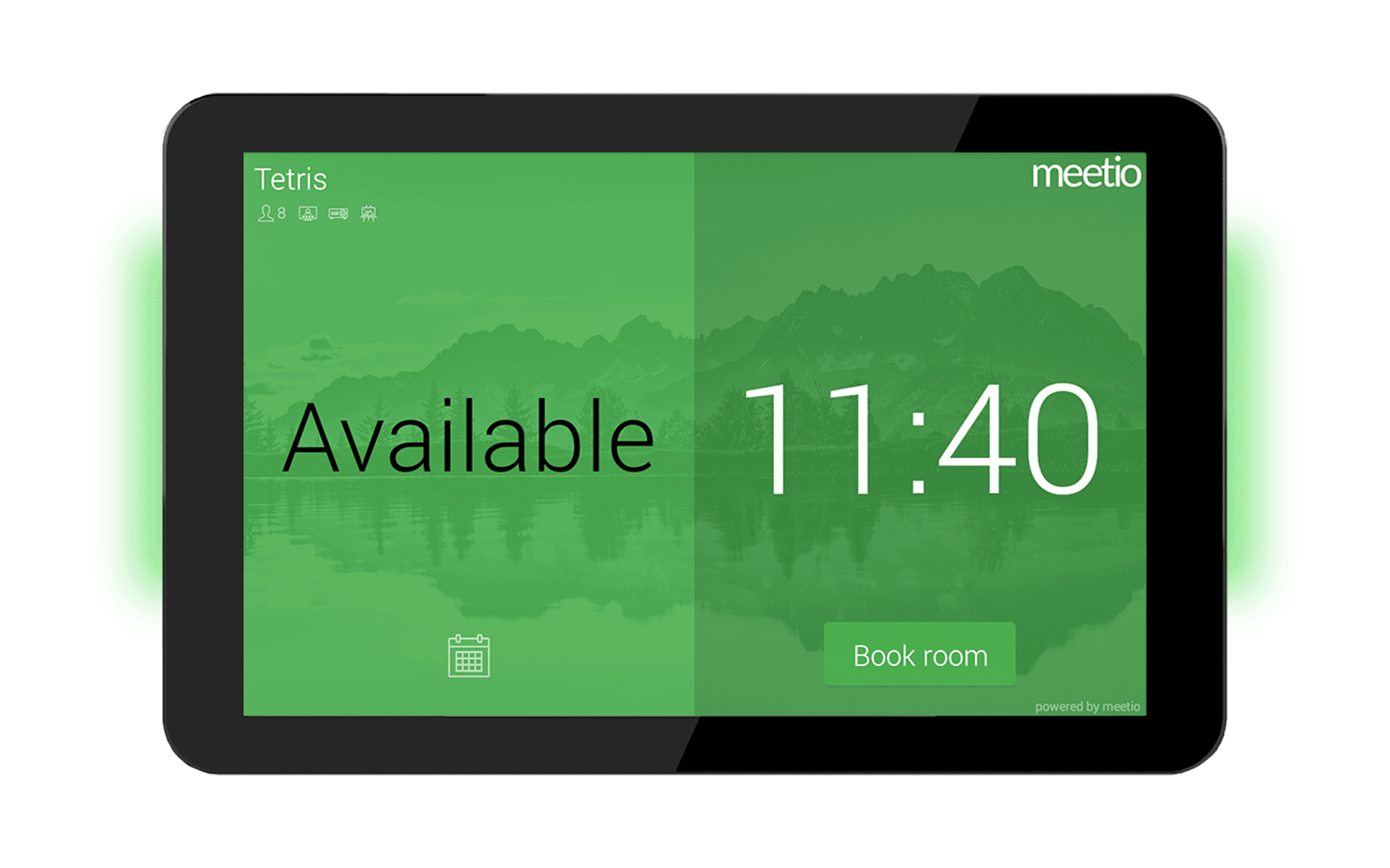 |
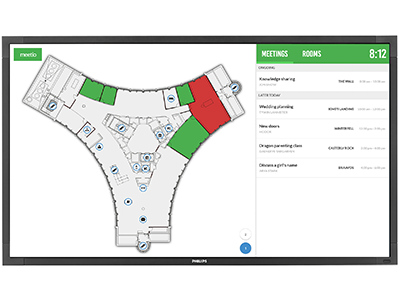 |
Employee wellbeing should without a doubt be the focus of any organization. And yes, we know that it sounds utopian, but just hang on. Because studies have shown a strong connection between wellbeing and productivity. This means that there’s a lot of incentive for management to care about their coworkers and their well-being.
There are of course a lot of different ways in which you can work towards higher well-being. Some of the tactics are more special than others, ever heard of Biophilia for example? No, it’s not a fetish for biology, or wait is it? Biophilia is when you design your office with natural elements such as plants or more earthy, natural colors in the belief that humans need a connection to nature or we suffer.
A more common way to increase productivity and at the same time increase wellbeing is listening to music while working. It’s been shown that different kinds of music can be beneficial for different types of tasks. Again, you have to consider what kind of environment you're working in. Perhaps it’s not the best idea to blast rock and roll music in an open floor office, but why not try a little office white noise? It's actually proven that ambient sounds without words increase productivity. So, maybe blast those rainforest sounds in the office?
Remote work has historically had a bad reputation but lately, we have seen more and more organizations adopting this kind of agile work model. Remote work means being allowed to work from anywhere outside of the office. Most commonly it means working from home. The reason that it got a bad rep before is that a lot of strict bosses seemed to think it would slow down productivity.
The truth is it hasn’t, but we’ll get into that in just a little bit. Firstly, it's important to know how it’s even possible to work from home, and in some cases, it isn’t. It depends of course on what kind of job you actually have. Remote work demands a digital workspace such as different cloud-based services like Google Drive. Through the cloud, you can reach your assignments and collaborate with your coworkers. At the same time, you can communicate with your coworkers through messenger applications such as Slack. All you need is good wifi and you’re all set to start working remotely.
As we mentioned before remote work hasn’t always been that popular. Historically the most productive person has been the guy in the corner booth who gets in at seven am and leaves at 10 pm. But it seems like all of that is changing. Because studies have actually shown that two-thirds of workers are more productive when working remotely.
Working remotely has also been known to give workers a much higher sense of work-life balance which in turn creates a higher work-life satisfaction. And we all know what higher satisfaction turns into? Higher productivity!
Another pro is the amount of flexibility it offers. We are not all cut from the same cloth. Some of us are more productive in the evening and others in the morning and so on. Working remotely creates the space to choose for yourself. You feel more in control and in charge of your own time.
Of course, there aren’t only pros of remote work. The biggest risk is that your work life and private life could easily float together and separating your time becomes more difficult. That could in turn lead to an increased stress level. Which is really bad. Another con of remote work is that some people just can’t motivate themselves while working alone from home.
There are ways to tackle that issue though. By using collaborative tools and having check-ins during the day even though you're working from home helps with motivation and increases productivity. It also helps to set hard deadlines for different assignments and projects. In that way, a sense of urgency arises and the motivation kicks in!
The workplace is constantly under contstruction. Trends come and go, but some changes become permantent. When the whole world closed down due to the Covid-19 pandemic in February 2020 no one knew that working from home would become the new normal.
It quickly became clear that working from home had its perks (and cons, of course). Several surveys have shown that most employees all over the world want to keep working from home from time to time. This leaves us with a new reality once again – it's time to say hello to the hybrid workplace.
Hybrid working refers to work both remote and from the office. Many organizations are in the middle of the transition to adapt their workplaces after the new standards. This can mean implementing a hot desking tool so that employees can book desks for the days that they come into the office and it can also mean that they are creating better environments for informal meetings and social gatherings to really lift the workplace experience. If you're interested – check out our guide on how to rethink your workplace design!

The third, and may we say so, the most important thing defining a workplace is the people inside it and the culture. Sometimes a workplace culture almost seems to live inside of the walls. It’s a phenomenon that has existed as long as companies have but it hasn’t been spoken about out loud for that long. It has just been, and for some it still is, what it is. But workplace culture actually has a great effect on productivity and the wellbeing of everyone working within your organization. So, maybe we shouldn’t just let it be? Maybe we should find out what creates a good workplace culture and what constitutes a bad one.
Let’s begin with investigating what bad workplace culture is and how does it start? Because of course no one wishes to work in an organization with a toxic culture but somehow it still happens. How come? A negative environment doesn’t just happen it arises when:
When the management levels of an organization aren’t transparent about important events or company information a distrust grows among the coworkers. And distrust is unfortunately known to only spread more distrust. Eventually, you’ll have a vicious circle on your hands. You have to be open and communicative to not pave way for information bottlenecks.
Yes, there is a wrong kind of competition. It’s when a team is turned too much against each other. When showmanship is rewarded and resentment between team members arises. That’s when you need to do something about it.
If we end up in a situation where we feel like we are the only ones actually working or some of our colleagues just aren’t held accountable for their performance (or lack of performance), a toxic culture is bound to start boiling. We need to set the same rules and standards for everyone.
Working too much isn’t good nor is it healthy for that matter. But it’s even worse when it seems to be for someone who doesn’t notice or give you credit for the work you’ve done. Overworked and underappreciated coworkers are bound to become resentful.
So, all of this negativity aside, how do you actually create a good workplace culture? From management’s point of view, it is actually pretty simple. A toxic environment is created when we feel mistreated, overlooked, or left out. Management’s focus should therefore be on communicating a lot and creating an environment where their coworkers always feel like they can say what they need to say.
Another important thing is to actually look. Who here needs help? Who is doing good and who is struggling? Just acknowledging your coworkers goes such a long way. And of course, holding everyone to the same standards and rules, but helping those who need it to reach those standards.
The last piece of the puzzle is to establish and be consistent with your company values. It helps not only your coworkers understand and feel proud of what your company actually stands for, but it also has an effect on the world around you. It helps your coworkers and customers understand who you are and makes it easier for them to get behind that. To feel part of it.
So what’s the key? How do you create a complete workplace? The truth is it depends. We know that’s a frustrating answer. Good workplace culture is of course important and please do follow our advice on how to get there. But when it comes to productivity and design the key lies within your organization. What makes your coworkers most productive and what kind of business do you have? Let those factors guide you in your decisions and use our guide to support you - and you’ll get there.
Meetio AB/Logitech Nordics AB
Hamngatan 4
211 22, Malmö
Sweden
Magnus Ladulåsgatan 3
SE-118 65 Stockholm
Sweden
Sweden: +46-(0)10-101 95 60